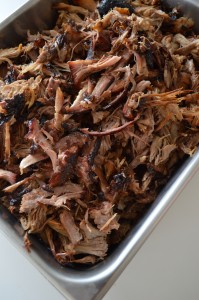 The term “barbecue” is used pretty loosely around these parts. Most often it refers to an outdoor grill, but I have also had “barbecued” items in restaurants that haven’t been anywhere near an outdoor grill. In fact, these items, usually ribs or pulled-pork, have been braised or even stewed in an acidic solution called “barbecue sauce”.
The term “barbecue” is used pretty loosely around these parts. Most often it refers to an outdoor grill, but I have also had “barbecued” items in restaurants that haven’t been anywhere near an outdoor grill. In fact, these items, usually ribs or pulled-pork, have been braised or even stewed in an acidic solution called “barbecue sauce”.
True barbecue is meat, usually pork, that has been smoked at low temperatures for several hours. Tough cuts that stand up to lengthy cooking are the most common, especially pork shoulder and ribs, as well as beef brisket. The home of true barbecue is the American south, notably the Carolinas and Tennessee. True barbecue is unlike any other meat. It is transcendent. Complex, aromatic smoke is the base flavour. Barbecue sauce is added towards the end of cooking, for a little acidity and sweetness. The real surprise is the texture. Meat that is stewed in barbecue sauce is touted as “tender”, but is usually just mushy. Meat cooked low and slow and dry is tender, but still has texture and bite.
Last summer barbecue pulled pork appeared on dozens of menus in the city, from high end restaurants to the familiar chains. Even Subway and Harvey’s hopped on the wagon. Few places prepared it properly. Luckily you can do it at home.
The beauty of the cooking method is it’s simplicity. You buy quality meat, and find a way to develop quality smoke, and that’s about it. A good barbecue sauce helps.
The only technique beyond this is something called the crutch, or Texas crutch. While you can let the meat cook uncovered in the smoker, you’ll find it takes hours and hours to tenderize. If you measure the internal temperature of the meat periodically, you’ll notice that it rises uniformly over time until it gets to around 150°F, when suddenly it plateaus, often for hours. This is because moisture at the surface of the meat is starting to evaporate. This is no good because collagen doesn’t start dissolving into gelatin until somewhere above 160°F.[1] If you’re patient, the temperature will rise. If you’re impatient, you can cover the meat to discourage evaporation, say by transferring the meat to a roaster with a lid, or by wrapping it in aluminum foil. Adding a little bit of liquid to the bottom of the crutch (water, cider, diluted cider vinegar, beer…) will also help the meat cooking a bit faster.
There is a trade-off in crutching your meat. The long, dry nature of barbecue heat darkens and hardens the surface of the meat into flavourful but chewy “bark” that is highly desired by most aficionados. I particularly like having it on pulled pork, as once the meat is shredded and mixed, the bark provides great texture. Crutching, by introducing moisture, inhibits bark formation.
It really is a matter of personal taste.
Pulled Pork
Ingredients
- pork shoulder (boston butt, or picnic ham)
- kosher salt
- black pepper
- barbecue sauce, a tangy, spicy variety of your choice
- The pork shoulder should be divided into large pieces, about 3 lbs each. The shoulder can be smoked whole, but breaking it up somewhat will give better smoke exposure. Breaking it up too small will create too many dry surfaces.
- Lay the shoulder on a wire rack, uncovered, in the fridge overnight to develop a pellicle.
- Season liberally with salt and pepper.
- Set in a 225°F smoker loaded with apple chips. Leave the meat to smoke for several hours.
- Optional: Periodically test the internal temperature of the pork with a thermometer. Once the inside is at 150°F, transfer the pork to a sheet tray or casserole with a 1/2 cup of water or cider or even cider vinegar in the bottom. Cover tightly with aluminum foil and continue to cook at 200°F.
- The pork is ready when a fork inserted in the meat releases easily.
- Let the pork cool to 110°F before pulling it. If the meat is cooked properly you should be able to tease it apart with two forks. Or throw on some gloves and bust it up with your fingers.
- Taste and adjust salt content as necessary.
- Toss with warm barbecue sauce immediately before serving.
- Consume on a soft, white but with an acidic coleslaw.
Further Reading
- Jeffrey Steingarten’s essay “Going Whole Hog”, from The Man Who Ate Everything. Does a good job describing the mania for barbecue in the southern states.
Reference
1. McGee, Harold. On Food and Cooking. ©2004 Scribner, New York. Page 150.

